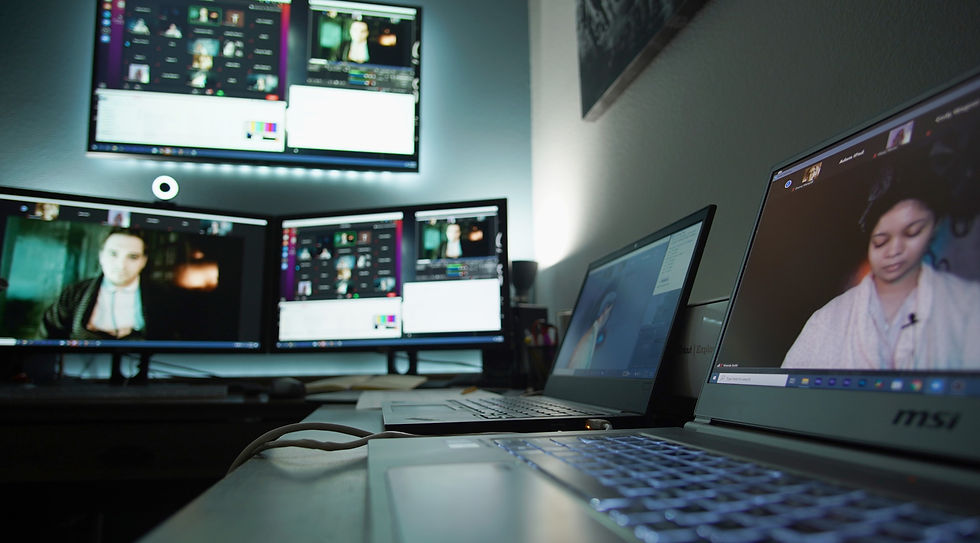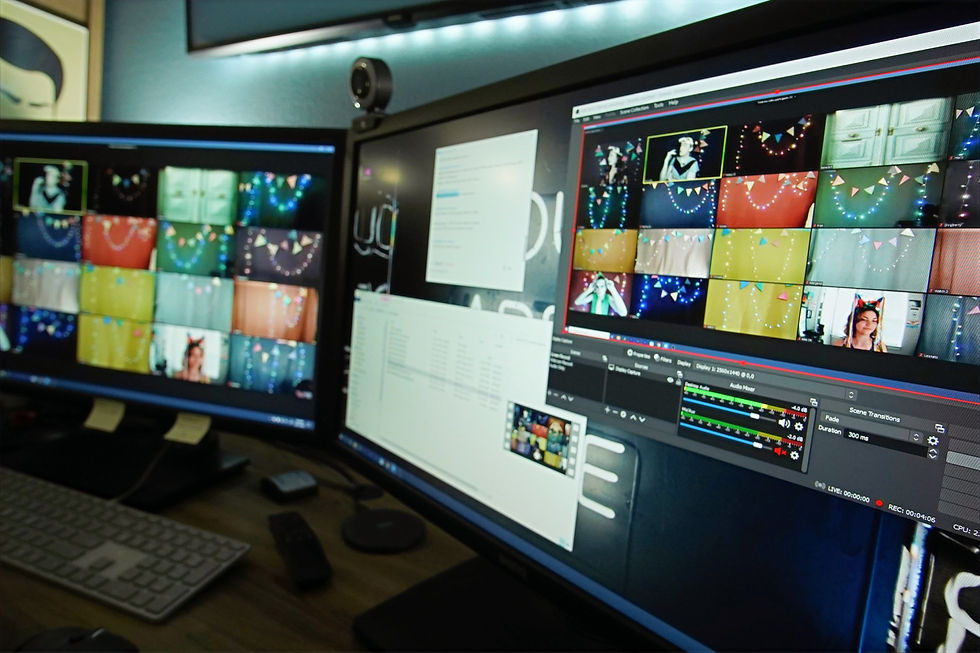The Show Must Go On | UNT Case Study
- Chris Salters
- Feb 28, 2021
- 5 min read
Updated: Apr 21, 2024
Like the rest of the world, 2020 dealt a difficult blow to theatre productions across the globe. Seats gathered dust, stages dark, and orchestra pits didn’t make a sound. The effects were felt from the likes of Broadway all the way down to the humble community theatre. Somewhere in-between landed prestigious theatre programs found at universities like the University of North Texas’ Department of Dance and Theatre. Hamstrung by protocols meant to keep students and faculty safe, the Department was searching for solutions to allow their theatre students an opportunity to not only perform, but perform for an audience.
An Unlikely Pair
With the spread of Covid-19 and the remote work that ensued, Zoom seemed like the logical avenue for the Theatre Department, but it left the problem of how to create a viewable performance to the public. That’s when I was approached by UNT to develop a completely remote production workflow for capturing the actors performing across Zoom with the end goal of delivering a feature-length theatrical production that would then be streamed to an audience. Solving problems and developing video-related workflows is a tantalizing carrot on the end of the proverbial stick, so I chomped at the opportunity.

The fall semester for UNT’s Department of Dance and Theatre would have two separate performances, The Diary of Anne Frank and Shakespeare’s Much Ado About Nothing, with two totally separate casts and crew. Each show would have between 14 and 21 total actors that would need to be recorded simultaneously, sync’d in post-production, and then edited into a final performance that looked less like a Zoom call and more like a movie.
The Remote Workflow
The Department had a modest equipment budget that, with my guidance, allowed them to procure quality webcams, decent lavalier microphones, and a small lighting setup for each actor. From the get-go this helped standardize the workflow I needed to design so that each actor could record themselves while on Zoom.

The actual recording would rely on the wonderful and amazingly free Open Broadcast Software or OBS. Each actor would funnel their external webcam through OBS and then into Zoom. For the full OBS workflow, check out the PDF below.

Recording the performances took about 20 hours across two days for each production. At the end of each day, actors would name their files following an easily trackable naming convention (ex. Act2_SceneB_AnneFrank.mkv) and then upload to a Dropbox link that sync’d directly with my system’s 24TB media raid.

Once all files made their way to my system I’d convert the OBS .mkv files into .mp4s and finally into edit-ready Prores .mov files. Even with an 8K capable system, this took some time. Eventually I would stumble upon Shutter Encoder, that would allow me to convert directly to Prores from a .mkv file, saving tons of time. From a video editor’s perspective, Shutter Encoder may be the best piece of freeware on the internet!
An Unexpected Snag
One logistical challenge that took me by surprise was managing resources on actor’s laptops. Many of the actors had laptops that were woefully underpowered for what we were attempting. Who can blame them? They were going to school to act, not develop software. Most of the computers could muster a Zoom call just fine, but once we started recording with OBS and running Zoom, then the problems started. Computers would freeze intermittently, audio would lose sync, or picture would just drop out completely.

Through the grace of some spare computers we muscled our way through Anne Frank’s story, but before starting down the path of Shakespeare and his larger cast, I needed another solution. That solution was in the almost-too-appropriately-named rentacomputer.com. I rented 8 Intel i7 Lenovo Thinkpad laptops and then remotely recorded actors with troublesome computers.
The World’s Largest Multicam?
That may be an exaggeration, but not by much. Syncing all of the media generated from the actors, plus reference recordings on my system, would not come easy. During performances, on my end, I would play a loud countdown and tone that would help me sync the 21+ individual recordings in post. Inevitably there would still be a slight delay in the sync across files due to connection speeds through Zoom. Ultimately what saved the day was the reference recording that had all the actor’s audio and video, not just individuals. This allowed me to visually and audibly sync actors when traditional automatic methods failed.

My go-to NLE is Premiere Pro, but I knew that attempting a 21+ multicam sync across a 2-hour long timeline would bring Adobe’s editor to its knees. Blackmagic’s DaVinci Resolve has been making huge strides as an offline editor and with its legendary stability plus utilizing the horsepower of both of my GPUs, I knew it was the right NLE for this job.

After breaking each performance into its individual scenes, I’d edit each scene as dictated by the script, and add music, sound effects, or other pluses as needed. Once all the scenes were cut, they were simply dropped into a master sequence, tightened, and exported.
One Problem, Two Solutions
The directors of each show along with script supervisors adapted the performances masterfully for Zoom, but in two completely different styles.
The Diary of Anne Frank was directed by Dr. Andy Harris who leaned on his experience in film and television for blocking. The end result felt similar to watching a film where the actors would frequently take up the full screen with cuts to other characters as needed. At times when multiple actors needed to be on screen, we broke the screen into stylized boxes housing anywhere from 2-8 actors at once. This afforded an easier edit as not all actors cameras were rolling for each scene, reducing the amount of media to be sync’d.
Embracing the use of Zoom for the performances, the director for Much Ado About Nothing, Sarah Rutan, leaned heavily into the humor of the play by leaving all actors on screen the majority of the performance in Brady Bunch-esq boxes. Topping off the look was the use of doors placed in front of each of the actor’s cameras that they would open and close when “entering” and “exiting”. The challenge to this approach was that the majority of the 21 person cast would be recording in every scene, giving my system a pile of pixels to plow through.
Curtain Call
I nor the faculty at UNT were sure what to expect when we started on this journey in July of 2020. When all was said and done though, both shows turned out beautifully in their own unique ways. The Diary of Anne Frank even garnered quite a bit of publicity thanks to what we accomplished!
